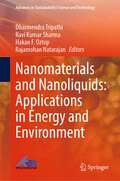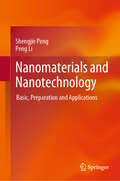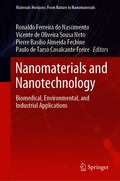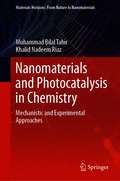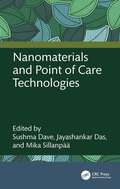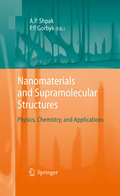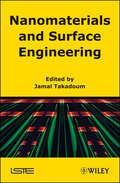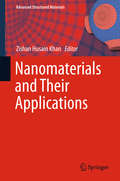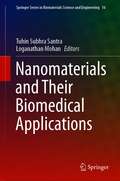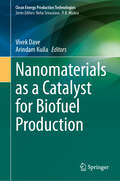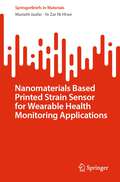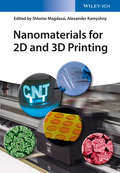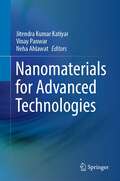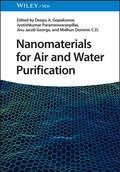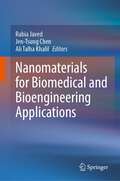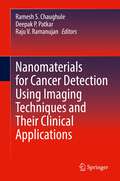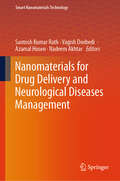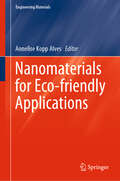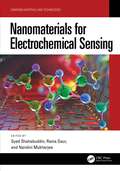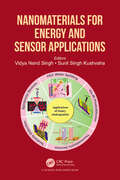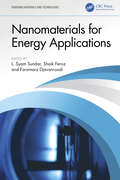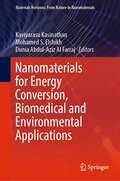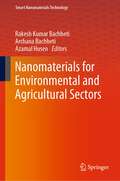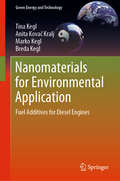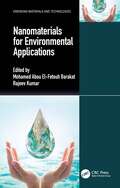- Table View
- List View
Nanomaterials and Nanoliquids: Applications in Energy and Environment (Advances in Sustainability Science and Technology)
by Dharmendra Tripathi Ravi Kumar Sharma Hakan F. Oztop Rajamohan NatarajanThis book discusses recent work on the use of nanoparticles in energy and environment-related work. This book presents experimental, numerical, analytical, and theoretical work on the use of nanomaterials in energy and environment. This book helps to highlight cutting-edge research and is a ready reference for the researchers working in this arena of academia and industries. This book provides insights related to various forms of nanotechnological applications in green buildings, environmental and electrochemical, solar distillation systems, green energy, storage tank of the SWH system, solar concentrator system's receiver, and CFD simulations of various aspects of nanofluids/hybrid nanofluids, which are particularly useful, valuable for the betterment of society.
Nanomaterials and Nanotechnology: Basic, Preparation and Applications
by Shengjie Peng Peng LiThis book first systematically introduces the development history, research content, and development trend of nanomaterials and then describes the preparation methods, characterization methods, physical and chemical properties, and mechanical properties of nanomaterials, so that students can have an overall understanding and understanding of nanomaterials. On this basis, the application of nanomaterials and carbon nanomaterials which are widely studied at present is taught. Finally, the latest research progress of nanomaterials is introduced. The book lists some practical examples as far as possible to make students easy to understand and master.
Nanomaterials and Nanotechnology: Biomedical, Environmental, and Industrial Applications (Materials Horizons: From Nature to Nanomaterials)
by Ronaldo Ferreira do Nascimento Vicente de Oliveira Sousa Neto Pierre Basílio Almeida Fechine Paulo de Tarso Cavalcante FreireThis book provides a complete overview of a wide range of nanomaterials from their synthesis and characterization to current and potential applications with special focus on the use of such nano-based products as functional agents in biomedical, environmental and industrial applications. It addresses the intrinsic relationship between aspects involving the synthesis of nanocompounds, their bio-physico-chemical properties and their interactions occurring in biomedical, environmental and industrial matrix. This book is of interest to engineers, academics and research scholars working in these fields.
Nanomaterials and Photocatalysis in Chemistry: Mechanistic and Experimental Approaches (Materials Horizons: From Nature to Nanomaterials)
by Muhammad Bilal Tahir Khalid Nadeem RiazThis book demonstrates the basic and fundamental aspects of nanotechnology and potential application as a photocatalysis in multiple application especially in environment and energy harvesting. This book also contains methods of preparation and characterization of unique nanostructured photocatalysts, and details about their catalytic action. The book consists of seven chapters, including the principles and fundamentals of heterogeneous photocatalysis; the mechanisms and dynamics of surface photocatalysis; research on pure and composites based materials with unique nanostructures; the latest developments and advances in exploiting photocatalyst alternatives to WO3; and photocatalytic materials for applications other than the traditional degradation of pollutants, such as carbon dioxide reduction, water oxidation, a complete spectrum of selective organic transformations and water splitting by photocatalytic reduction. This book will appeal to a wide readership of the academic and industrial researchers and it can also be used in the classroom for undergraduate and graduate students focusing on heterogeneous photocatalysis, sustainable chemistry, energy conversion and storage, nanotechnology, chemical engineering, environmental protection, optoelectronics, sensors, and surface and interface science.
Nanomaterials and Point of Care Technologies
by Sushma Dave Jayashankar Das Sillanpää MikaPoint of care (POC) diagnostic devices are predominantly used for the diagnosis and monitoring of diseases. To make these technologies scalable for manufacturing, user-friendly, inexpensive, sensitive, and rapid, a combination of such devices with nanomaterials is required. This book deals with new emerging fields such as POC technologies and advanced nanotheranostics using nanomaterials and their technologies and applications in diagnosis. In this book, current advances for the application of nanomaterials such as carbon nanotubes, graphene, and magnetic nanoparticles in POC devices and future directions are reviewed.This book: Presents a comprehensive account of needs and challenges of POC diagnostics Describes the fundamentals of rationale of nanomaterials as remarkable building blocks for biosensing Discusses development of critical diagnosis in POC systems Deals with the advantages of nanomaterial-based sensing strategies Illustrates the challenges and breakthroughs of technologies for cost-efficient biosensing platform The book is aimed at researchers and professionals in nanotechnology and biomedical engineering.
Nanomaterials and Supramolecular Structures
by Petr Petrovych Gorbyk Anatoliy Petrovych ShpakThe text features experimental investigations which use a variety of modern methods and theoretical modeling of surface structures and physicochemical processes which occur at solid surfaces. Nanomaterials and Supramolecular Structures: Physics, Chemistry, and Applications is intended for specialists experienced in the fields of Nanochemistry, Nanophysics, Surface Chemistry (and Physics), synthesis of new nanostructural functional materials and their practical applications. It will also prove useful to students, post-graduates, researchers, and lecturers.
Nanomaterials and Surface Engineering (Wiley-iste Ser.)
by Jamal TakadoumThis book covers a wide range of topics that address the main areas of interest to scientists, engineers, and students concerned with the synthesis, characterization and applications of nanomaterials. Development techniques, properties, and examples of industrial applications are all widely represented as they apply to various nanostructured materials including nanocomposites and multilayered nanometric coatings. It is recommended to anyone working in the field of nanomaterials, especially in connection with the functionalization and engineering of surfaces.
Nanomaterials and Their Applications (Advanced Structured Materials #84)
by Zishan Husain KhanThis book focuses on the latest advances in the field of nanomaterials and their applications, and provides a comprehensive overview of the state-of-the-art of research in this rapidly developing field. The book comprises chapters exploring various aspects of nanomaterials. Given the depth and breadth of coverage, the book offers a valuable guide for researchers and students working in the area of nanomaterials.
Nanomaterials and Their Biomedical Applications (Springer Series in Biomaterials Science and Engineering #16)
by Tuhin Subhra Santra Loganathan MohanThis book highlights the evolution of, and novel challenges currently facing, nanomaterials science, nanoengineering, and nanotechnology, and their applications and development in the biological and biomedical fields. It details different nanoscale and nanostructured materials syntheses, processing, characterization, and applications, and considers improvements that can be made in nanostructured materials with their different biomedical applications. The book also briefly covers the state of the art of different nanomaterials design, synthesis, fabrication and their potential biomedical applications. It will be particularly useful for reading and research purposes, especially for science and engineering students, academics, and industrial researchers.
Nanomaterials as a Catalyst for Biofuel Production (Clean Energy Production Technologies)
by Vivek Dave Arindam KuilaThis contributed volume addresses several environmental problems using nanoparticles/nanomaterials for renewable energy and biofuel production. It presents nanomaterials as catalysts that can enable better selectivity, yield, and quality in renewable energy and biofuel production. The rapid expansion of industries and human population has resulted in a significant increase in the generation of waste and environmental pollution, posing a significant threat to the environment and human health. People are looking for safer and more eco-friendly fuels to meet energy demand and preserve the world for future generations. Renewable energy and biofuels are alternative techniques that reduce fossil fuel consumption. The advancement in the field of nanotechnology has led to the development of nanocomposites/nanomaterials, which are composed of nanoscale particles and polymers. Their application in the environment has shown great potential in addressing environmental issues such as pollution control and waste management. Nanocomposites are advanced materials with unique properties, such as improved mechanical strength, thermal stability, and flame resistance, making them attractive for a wide range of applications, including environmental applications. Nanomaterials show great potential for sustainable biofuel production with commercial feasibility. Nanotechnology-based various conversion routes effectively convert waste biomass into value-added biofuels, such as syngas, biodiesel, and HVO. This book discusses the green synthesis of nanocomposites/nanomaterials for biofuel production and renewable energy. Additionally, it covers techno-economic analysis of bioremediation using green-synthesized nanoparticles/nanomaterials. This book will be helpful for researchers, engineers, and scientists working in the areas of environmental biotechnology, materials science, nanotechnology, environmental science, and engineering.
Nanomaterials Based Printed Strain Sensor for Wearable Health Monitoring Applications (SpringerBriefs in Materials)
by Mariatti Jaafar Ye Zar Ni HtweThis book reviews different types of nanomaterials-based-conductive inks used to develop printed strain sensors, printing fabrication methods, and applications such as wearable health monitoring. Printed wearable electronic devices have recently drawn a lot of attention, as shown by the increasing number of publications and commercialized devices covering various facets in emerging fields. Many researchers are working toward optimizing nanoparticle-based-conductive inks for wearable electronics. However, issues related to its stability, dispersion, and annealing temperature often limit its applications. General important information and requirements of flexible electronics for health monitoring are covered in the book chapter. The target audiences are researchers and students who are involved in the development of printed wearable electronics.
Nanomaterials for 2D and 3D Printing
by Alexander Kamyshny Shlomo MagdassiThe first book to paint a complete picture of the challenges of processing functional nanomaterials for printed electronics devices, and additive manufacturing fabrication processes. Following an introduction to printed electronics, the book focuses on various functional nanomaterials available, including conducting, semi-conducting, dielectric, polymeric, ceramic and tailored nanomaterials. Subsequent sections cover the preparation and characterization of such materials along with their formulation and preparation as inkjet inks, as well as a selection of applications. These include printed interconnects, passive and active modules, as well as such high-tech devices as solar cells, transparent electrodes, displays, touch screens, sensors, RFID tags and 3D objects. The book concludes with a look at the future for printed nanomaterials. For all those working in the field of printed electronics, from entrants to specialized researchers, in a number of disciplines ranging from chemistry and materials science to engineering and manufacturing, in both academia and industry.
Nanomaterials for Advanced Technologies
by Jitendra Kumar Katiyar Vinay Panwar Neha AhlawatThis book presents experimental as well as simulation methodologies for analysis and development of nanostructures for introducing the desirable effects through modifications in the basic structure of select nanomaterials. The initial chapters in this book focus on exploring the basic aspects of nanomaterials, e.g., distinguishing features, synthesis, processing, characterization, simulation and application dimensions, or nanostructures that enable novel/enhanced properties or functions. The chapters also cover the size-dependent electronic, optical, and magnetic properties of nanomaterials in exposing the specific properties essential for applications in nanophotonics, nanoplasmonics, nanosystems (e.g., biological, medical, chemical, catalytic, energy, and environmental applications), and nanodevices (e.g., electronic, photonic, magnetic, imaging, diagnostic, and sensor applications). This book is a useful resource for students, researchers, and technologists in gathering recent knowledge on novel nanostructures and their use in different application areas.
Nanomaterials for Air and Water Purification
by Deepu A. Gopakumar Jyotishkumar Parameswaranpillai Jinu Jacob George Midhun Dominic C.D.Nanomaterials for Air and Water Purification A comprehensive primary resource for researchers interested in nanocomposites for environmental remediation In Nanomaterials for Air and Water Purification, a team of distinguished researchers delivers an expert compilation of resources dealing with nano-based research for air and water remediation. The editors have included works by reputed researchers covering characterization, fabrication, and applications. This book is intended as a primary reference for researchers in academia and industry to offer original insights into environmentally friendly polymers and their nanocomposites. It provides comprehensive discussions of the fundamentals, attributes, characteristics, and fabrication of the materials and composites relevant to these nanomaterials. Readers will also find: Thorough introductions to electrospun nanofiber membranes for effective air filtration and nanocomposite air filter membranesComprehensive explorations of photocatalytic materials and technologies for air purificationPractical discussions of opportunities for improving and protecting water supplies with nanomaterialsFulsome treatments of polymeric membranes incorporated with metal or metal oxide nanoparticles for water purification Perfect for environmental, polymer, and surface chemists, Nanomaterials for Air and Water Purification will also earn a place in the libraries of industry professionals with an interest in water and air purification.
Nanomaterials for Biomedical and Bioengineering Applications
by Rabia Javed Jen-Tsung Chen Ali Talha KhalilThis book accumulates the most recent advancements in the field of bioengineering regarding hybrid science named nanobiotechnology and enriches the readers with vast and comprehensive knowledge about different biomedical applications of nanomaterials. It includes drug and gene delivery, tissue engineering, antimicrobial properties, hyperthermia, cancer therapy, bioimaging, biosensing, photoablation therapy, etc., utilizing the potential of different nanomaterials that are helpful for the well-being of diseased individuals. Furthermore, the concerns about multidrug-resistant microorganisms are increasing daily in the healthcare system. Since conventional therapies fail to combat various infectious diseases, novel nanotechnology techniques provide an alternative approach to developing innovative biomaterials. The novel features of nanomaterials need to be exploited for use in the biomedical engineering domain. They should be fabricated so that the novel multifunctional nanomaterials notonly improve drug efficacy but also reduce their side effects. Moreover, a detailed understanding of the nanotoxicological effects of promising biomedical nanomaterials should necessarily be explored using the cell culture approach. Corona of nanomaterials should be investigated in detail to determine its fate in the biological system regarding safety concerns. This is the most important feature that is novel and explored in this book and would be very helpful for customers like clinicians, scientists, engineers, and technicians who will gain extensive knowledge from this book and work together to get the desired results in the healthcare sector.
Nanomaterials for Cancer Detection Using Imaging Techniques and Their Clinical Applications
by Ramesh S. Chaughule Deepak P. Patkar Raju V. RamanujanThis book presents nanomaterials for cancer detection using a variety of state-of-the-art imaging techniques. Clinical applications are also highlighted. The unique size-dependent properties and convenient surfaces for molecular assembly make these nanomaterials essential for a variety of innovative imaging techniques. This book covers important imaging modalities, synthesis of nanoparticles with specific functional properties, and clinical applications including the development of anticancer drugs. The information presented here involves contributions from chemistry, materials science, materials characterization, cell engineering, and clinical testing.The book will be essential reading to experienced clinicians as well as a wide range of scholars and researchers interested in nanotechnology and imaging techniques for cancer detection.
Nanomaterials for Drug Delivery and Neurological Diseases Management (Smart Nanomaterials Technology)
by Nadeem Akhtar Azamal Husen Vagish Dwibedi Santosh Kumar RathThis book gives a complete overview of current developments in the nano drug delivery technology in the management of neurological disorders and brain diseases. The book is divided into three main sub-sections: A) Fundamental study on nanomaterials, nanocarriers, and nanoformulation-based drug delivery in neurological diseases management, B) Nano drug delivery therapy - a novel approach towards common neurological disorders and C) Novel nano delivery strategies in targeted neurological diseases management. This collective work presents diverse nano-based drug delivery technologies that are high-throughput, reliable, pioneering, and applicable to researchers of different countries despite their socio-economic conditions. It hopefully encourages researchers, innovators and policymaker to adapt nanomaterial-based drug delivery vehicles technologies using diverse nano-based formulation techniques as targeted therapy for treating and managing neurological disorders.
Nanomaterials for Eco-friendly Applications (Engineering Materials)
by Annelise Kopp AlvesThis book presents a wide range of synthesis and characterization techniques to produce ceramic nanomaterials specially developed to be used in environmental applications. The book cover synthesis using hydrothermal, chemical vapor deposition, sol-gel, emulsification, magneto-sputtering, among other process and modern characterization techniques with detail. The use of the synthesized materials in eco-friendly approaches such as photocatalysis, solar energy efficiency improvement, absorbents, sensors, solar cells, biofuels and waste reuse are reported in detail.
Nanomaterials for Electrochemical Sensing (Emerging Materials and Technologies)
by Syed Shahabuddin Rama Gaur Nandini MukherjeeThis book reviews the fundamentals of electrochemical sensors, the preparation of electrodes, potential materials for sensing applications, and different analytical methods used for electrochemical sensing applications. It further covers the designing of various electrodes and electrode materials, instruments, sensing mechanisms, advanced nanomaterials for sensing, and so forth. The scalability and commercialization of electrochemical sensors and the challenges and prospects of electrochemical sensors are also described.Key Features: Provides an overview of the advances in the application of nanomaterials in sensing Covers basic fabrication techniques of electrodes as an important part of electrochemical sensors and analysis Reviews the use and analysis of different types of nanomaterials and nanocomposites used for fabrication of working electrodes Emphasizes carbon-based nanomaterials, 2D nanomaterials, and advanced nanocomposites comprising various matrix systems such as conducting polymers, and Explores electron transfer, redox behaviour, fabrication techniques, data interpretation, and advanced nanomaterials as working electrode materials This book is aimed at researchers and graduate students in nanomaterials, electrochemistry, chemical engineering, and materials science.
Nanomaterials for Energy and Sensor Applications
by Vidya Nand Singh Sunil Singh KushvahaNowadays, most of the research focuses on nanomaterials in which one of the dimensions falls in the 1-100 nm range. These nanomaterials can be thin films, quantum dots, nanowires, nanopyramids, and nanoclusters. Thus, nanomaterials are impacting almost all aspects of materials for various applications in emerging energy and sensor devices. The book comprises ten chapters and discusses nanomaterial applications in energy, solar cells, water splitting, sensors, etc. The book caters to budding researchers’ needs in synthesizing nanomaterials and post-graduate students.
Nanomaterials for Energy Applications (Emerging Materials and Technologies)
by L. Syam Sundar Shaik Feroz Faramarz DjavanroodiNanomaterials for Energy Applications provides readers with an in-depth understanding of advanced nanomaterials and their applications in energy generation and utilization concepts. It focuses on emerging nanomaterials and applications in various energy-related fields. Describes nanomaterials for use in photovoltaic cells, solid state lighting, fuel cells, electrochemical batteries, electrochemical capacitors, superconductors, hydrogen storage, and photocatalysts. Focuses on commercial and economic aspects. Includes case studies drawn from practical research. This book is aimed at researchers, advanced students, and practicing engineers in the disciplines of materials, mechanical, electrical, and related fields of engineering.
Nanomaterials for Energy Conversion, Biomedical and Environmental Applications (Materials Horizons: From Nature to Nanomaterials)
by Kaviyarasu Kasinathan Mohamed S. Elshikh Dunia Abdul-Aziz Al FarrajThis book highlights a multidisciplinary system for the future while protecting our environment. Certainly, the main objective of the proposed book has addressed several issues and bringing a good platform to understanding for future developments in metal oxide nanostructures for energy conversion, biomedical, and environmental management, however, which is support/carrier for antibacterial behaviors, pathogen infections, and bioinspired materials for energy savings and environmental impacts. Appropriately, I recommend the book to undergraduates, postgraduates, and doctoral students those who are working in materials science and researchers across the world working in interdisciplinary research.
Nanomaterials for Environmental and Agricultural Sectors (Smart Nanomaterials Technology)
by Rakesh Kumar Bachheti Archana Bachheti Azamal HusenThis book gives a complete overview of current developments in nanotechnology-based environmental remediation and sustainable agriculture practices/sectors. It will provide the use of nanotechnology in the agricultural sector such as crop production and improvement, soil fertility management along with benefits and risks of nanotechnology on ecological farming. Additionally, the book also discovers how nanotechnology is used in water, air remediation techniques and major challenges in using nanomaterials for improving water and air quality. The book can be a reference source for academicians, scientists, policymakers, students, and research scientists working in minimizing the environmental pollution and increasing agricultural production using nanoparticles.
Nanomaterials for Environmental Application: Fuel Additives for Diesel Engines (Green Energy and Technology)
by Tina Kegl Anita Kovač Kralj Marko Kegl Breda KeglThis book explores the use of nanomaterials as diesel fuel additives. It extensively reviews the diesel engine characteristics and the most frequently used nanomaterials and nanofuels and discusses the practical issues regarding the viability of nanomaterials as fuel additives from technical, environmental, and human health viewpoints. Special attention is focused on questions related to the short-term use of nanomaterials in diesel engines, such as: · What are the most important nanomaterial activities in diesel engines? · What happens to nanomaterials at various stages, from the fuel tank to exhaust? · What are the effects of nanofuel usage on diesel engine characteristics? and · What are the effects of nanomaterials on diesel engine parts and systems? Given its scope, this book is a valuable resource for researchers and engineers in environmental science, mechanical engineering, and chemical engineering fields, as well as for advanced undergraduate and postgraduate students.
Nanomaterials for Environmental Applications (Emerging Materials and Technologies)
by Mohamed Abou El-Fetouh BarakatNanomaterials for Environmental Applications offers a comprehensive review of the latest advances in nanomaterials-based technologies for the treatment of emerging contaminants in wastewater. It describes the latest developments in the synthesis protocols, including the synthesis of different kinds of nanostructure materials using various physical and chemical methods. Features Discusses the synthesis and characterization of important nanomaterials such as carbon nanostructures, metal and metal oxide nanostructures, polymer nanostructures, and smart 1D-–3D nanomaterials Presents the latest techniques used in the characterization of nanomaterials Covers environmental applications including the remediation of pollutants in wastewater and water purification and disinfection Examines the sources, fate, transport, and ecotoxicology of nanomaterials in the environment. Aimed at researchers and industry professionals, this work will be of interest to chemical, environmental, and materials engineers concerned with the application of advanced materials for environmental and water remediation. Mohamed Abou El-Fetouh Barakat is a Professor of Environmental Sciences at both King Abdulaziz University (KAU)- Saudi Arabia, and Central Metallurgical R&D Institute (CMRDI)- Egypt. He is highly qualified in the fields of industrial waste management and pollution control as well as catalysis and nanotechnology. His experience includes academic research works in Japan, Germany, the United States and Saudi Arabia, as well as initiating and leading industrial research projects in Egypt jointly with the United States. Rajeev Kumar is an Associate Professor in the Environmental Science Department, King Abdulaziz University, Jeddah, Saudi Arabia. His research activities are in the areas of wastewater treatment and materials science. He studies the adsorption and photocatalytic properties of nanomaterials for the removal of contaminants from wastewater.
